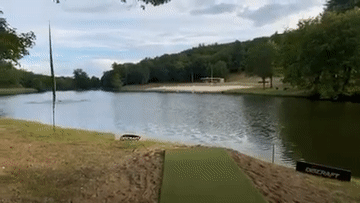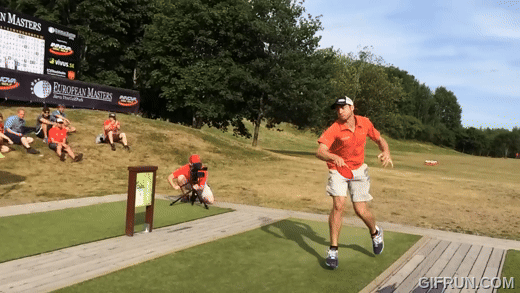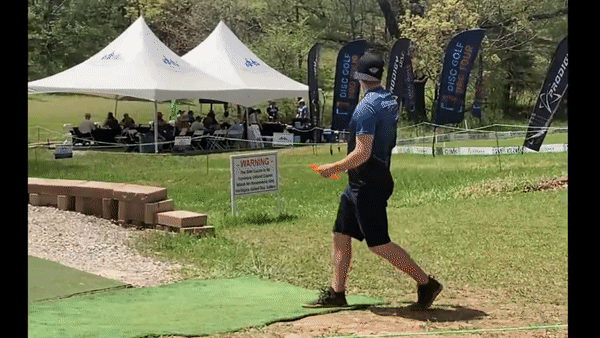Thanks.
Hoping to be tactful, but... that sounds a little more like trying to convince me (or you). I am okay with accepting it as GRAS (generally recognized as true.)
I can't think of another sport where throwing an object requires you to hang on to it harder. A baseball rolls off your fingers and is being pushed at the last point of contact. A disc is being pulled back towards you if it is ripping out, so you are applying a force that is opposite the direction of travel. That doesn't mean I don't believe it works, it just seems to demand more explanation. (Oh, and just why doesn't this work for a forehand again?)
My naive assumption up to this point has been that as soon as I get mechanics working better, the disc will go fast enough to rip out. This is a bit of a paradigm shift, in that now we're told we should ensure it rips out first. "The disc has to rip out of your hand" is considerably different from "you have to make sure you let the disc rip out of your hand." Like channelling Eugene Herrigel.
Rain on the way, going to dash to the soccer field and play with this.
Hopefully neither kind of convincing at the top there (but I appreciate it when you call it out and sorry if it came across poorly in any way). I was just trying to offer a few tests, some N=1 firsthand testing paired with subjective experience I can't really see on camera, and some bio-hand waving trying to find words for what I think I happening but I'm not entirely sure. This is one of those areas where my curiosity is higher than my instructiveness around DGCR so I apologize since I am aware that it kind of muddies any "learning nuggets" people come to DGCR for. I'll try to clarify a little here (while admitting I currently have a limit to how clear I can be in words).
I would definitely clarify and not say what I was trying to describe was a "pull back" so much as just a way to describe the way the muscularizartion unfolds in the move and the interaction of masses etc. When you are holding onto something swinging or throwing it different motions all have some kind of tension/resistance/pressure patterns. So it's more that flow I am attempting to more fully understand.
I agree/I'm not thoroughly fond of the "ripping out" phrase for some of the reasons you're raising and am trying to back off that a bit. Leveraging/pounding/pulling around/swinging out all describe something like what I am talking about.
The hammer "solved" this problem for me, and didn't really work more dramatically until a lot of other work on my posture and chain. But is that the way it always works? How close is it across players? Dunno. I suspect more similarities than not, but remain curious. Hand 20 touring pros hammers and do they all "get it"?
I sympathize with your Herrigel comment. In general I have now found so many ways to break the chain, and in some sense you just need what happens at the end of the move to work as well as everything else for the maximum yields. Maybe a couple of my nuggets/ahas below will help.
Any of the most effective hammer-y backhand moves I have myself used are just... stranger than other thrown moves (and work in context of posture and sequence) as we get into below:
You've actually written the answer here I believe.
Throwing sports that I can think of ALL push from behind the object in question at the last point of contact.
It's the same with a forehand since we are able to push it forward via the inside of the rim; the rim becomes the seams of the baseball. We are effectively pushing from behind the last point of contact. Sports that utilize that push as the last point of contact are doing so from the trailing arm which more efficiently utilize stretch mechanics in which case loose muscles are more stretchy.
For the disc golf backhand we are
1) pulling from in front of the object at the last point of contact and
2) using the lead shoulder
This would be similar to snapping a towel on the backhand side or throwing a baseball with your hand in front of it (like a yo-yo).
Snapping a towel you would either never think of letting go of the handle or if you did the towel would whip much less quickly.
With the baseball being thrown from the position of holding a yo-yo you can imagine
1) how you would much more easily lose grip on it before getting to the hit and
2) how when you snap your hand back toward you with the yo-yo you can increase the spin (and thus achieve the coveted "walk the dog" trick).
In the case of being literally as loose as possible on the backhand you would just collapse the pocket and put the arm in an intrinsically weak position.
I hope my oversimplified analogies make some sense.
I would generally agree with this. Would tease that you and I have discussed a couple fundamentally different approaches to the sequence and emphasis among coaches. Still a few things worth saying/studying there IMHO.
I sympathize with this being kind of weird

On the other hand, it honestly sounds like your confusion is actually an understanding! I think some people confuse the concept of 'not actively releasing/opening' with...death gripping the disc. You are correct to point out that a baseball would never be thrown with a death grip, and neither will a disc.
The key to this whole thing is leveraging the right part of the disc, and doing it powerfully. I am trying to think of ways to describe it with words that might help, and its challenging.
Its a super simple concept in the end, so...just hold a disc with your grip. Hold the disc out in front of you, where your grip is on the 3'oclock side. If you grab the disc with your left hand at 12 o'clock and try to pry the disc out in a way where your pinky, then ring, then middle finger lose their power, how does that go? If you grab it with your left hand at about the 7 o'clock and try though, pretty easy to free it from those fingers eh?
That is pretty much what you want to figure out imo. Create the leverage on that side of the disc with enough acceleration and you will not have to let go.
Thank you for additional sympathy on the weirdness. That's basically why I'm frustrated trying to describe it. It's effin weird, dude, which is why I'm annoyed I can't write a "complete" account or how it works. But it
somehow works and that's where you and I meet on the "throw other stuff to figure out what they have in common" theory, at least in the personal growth.
On that note, I had two "just do it" stories.
1. The first one was frankly kind of upsetting since I work so much harder on my backhand. I was alarmed when I did a bunch of full body club exercises for a couple months then could immediately throw a competent tomahawk and thumber farther more easily and accurately than I ever had before. No detailed shift analysis, no Brychanusing posts,[COLOR=var(--text)] nothing. You barely heard me say anything about it until now because my body went "aha!" immediately. I'm sure I could look at film and find stuff to pick at, but I didn't even bother because I got the gist in
exactly one try. It never became intellectually very interesting to me because I didn't need it to learn, and after I felt how it worked I was like "yeah, that's probably something like how overhand pitching works." Just needed to do a lot of something else that made sense to my body first.[/COLOR]
2. Backhand "hammertime" aha that I suddenly remembered and I'm glad I did. I had been dealing with a version of "too loose" like Josh mentioned that I call "floppy wrist syndrome." Around that time I started doing the Blake T hammer pound drills for the very end of the move. I was throwing a 200' hole. On my first shot I had floppy wrist syndrome. Got to the hole, but I was there to dispel floppy wrist so I threw again. Second shot I just tried to make it the Comet feel exactly like the Blake drill. Sent the Comet 100' long and turning to the right (which incidentally stacks up with the ~10mph I measured later). After that I just started trying to do it over and over in standstills, upshots, and putts until not doing it felt awful and weak, and the results spoke for themselves. Translating it to the additional movement in X-step is related to more failures points in the chain, but always works the same way on the fastest shots. I have had only a small handful of true large "ahas" in backhand like that. The rest have all been huge amounts of work.
So practically speaking I might not bother trying to say more than what you said so nicely, RB:
"The key to this whole thing is leveraging the right part of the disc, and doing it powerfully. I am trying to think of ways to describe it with words that might help, and its challenging."
Coaching: I don't bother talking about most of this. People either seem to get the point of the hammer for grip and leveraging out/Blake T style wrist drills or they don't. If they don't, I just move to something else more quickly. Sometimes it works better for them later. Sometimes people never make the connection.
Hammertime and histories/body training: Climo was a carpenter, sidewinder played baseball, RB was a wrestler (plus some climbing I think?), I boxed and had a very developed upper body at my peak training with a very strong grip. Maybe the way those activities kinetically connects to hammers and works for some people is a bit different than other. I tried to help someone figure it out early on after my personal "hammer revelation" and he did all kinds of things with the disc and hammertime that would never occur to my brain or body to do, and none of it worked for him, and we moved on to something else, etc. Josh probably got the connection to rackets way faster than I ever would, etc.
It's weird. Very weird.



